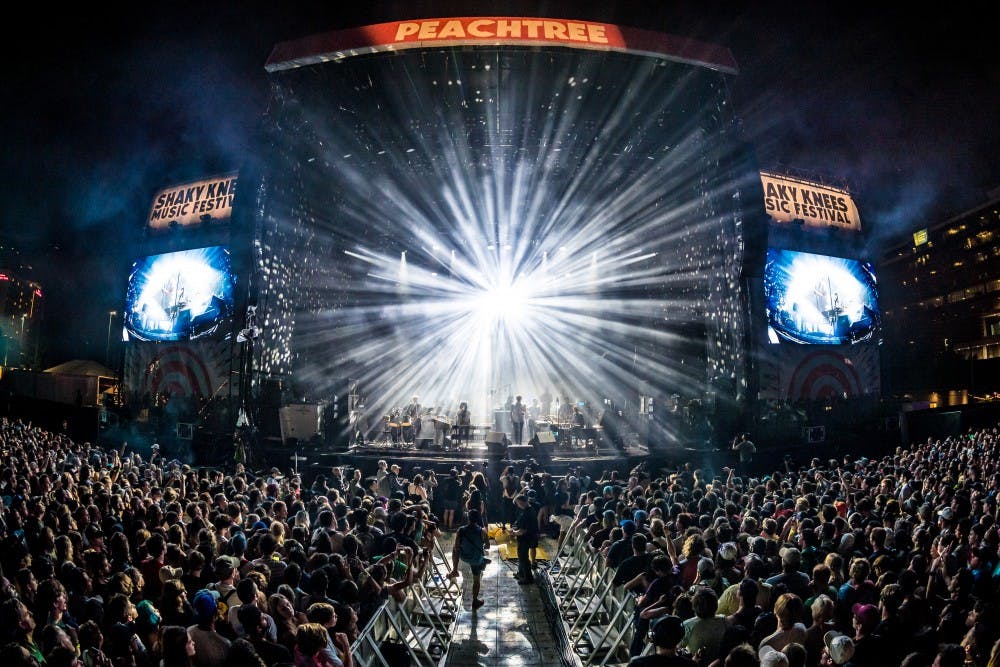One of the first sights a visitor to the Shaky Knees Music Fest sees upon rounding the corner into Atlanta’s Centennial Olympic Park—after, of course, the high-tech security lines, lest someone smuggle in some outside food or drink—is an oversized Popeye’s chicken leg, placed conspicuously amid the various food vendors in the middle of the park. Walk a little further in and you’ll hear the cries of Coca Cola salespeople imploring you to grab an “ice cold Coke” on the way to your next show, just across from the giant selfie camera that ominously reads “smile, you’re on camera” underneath a graphic of a blinking, all-seeing eye. (Naturally, the whole display is sponsored by Ford.)
For a festival that prizes the increasingly nebulous genre of “indie rock,” a designation that had its roots in the rejection of major corporations and bureaucracies, the baldly corporate feel of Shaky Knees seemed to ring false with the acts it featured. But the Atlanta festival is just one of the latest in a string of well-funded music festivals that have capitalized on a post-millennial obsession with these booze-filled weekends of concerts.
The festival craze of the last decade or so can be traced directly to California’s Coachella Valley Music and Arts Festival, which has ascended to household name status since its start in 1999. Though it came just after the disastrous Woodstock ‘99, Coachella, too, has sought to emulate the “three days of peace and music” vibe of the former’s 1969 forebear. It’s telling that today Coachella is perhaps more associated with its garish costumes and flower crowns than with its actual music.
In the wake of Coachella’s success, promotion companies have spawned a number of festivals made in Coachella’s image: Tennessee’s Bonnaroo, the now-international Lollapalooza, New York’s Governors Ball and, of course, Atlanta’s Shaky Knees. The proliferation of “destination festivals,” where visitors travel across the country to places like Indio Valley or Randall’s Island for a weekend (or two) of revelry, has driven promoters to attract ever-greater rosters of artists—the hallowed “lineup,” whose releases rival surprise album drops in their hype.
The issue with these destination festivals is that, ironically, they result in the erasure of their very “destination.” At their best, music festivals showcase the character and movements of their surroundings. But visiting a festival like Shaky Knees, with a lineup boasting LCD Soundsystem, The xx and Phoenix, one gets the feeling that the same production could have occurred in Atlanta or New York or Austin—and it would have made little difference. This problem is only exacerbated by a sense of homogeneity between these festivals’ lineups. How many times have we seen Radiohead, Arcade Fire and Kendrick Lamar in large print atop a festival poster? Promoters have successfully distilled the Coachella formula of “festival culture” and outsourced it across the world.
Aside from the geographical integrity of these festivals, economic barriers to entry are especially pronounced. Much has been made of Coachella’s status as a haven for wealthy white kids, and the average price of tickets to festivals like it ranges from between $200 and $500 for general admission and in the thousands of dollars for coveted VIP packages. (This trend of “luxury” festivals reached a tragicomic nadir this spring with the doomed Fyre Festival, whose day tickets sold for $1500 a piece.) Even Durham’s Moogfest, whose tech-driven mission is decidedly different from a stereotypical festival, has come under fire for exorbitant fees. If a music festival neither incubates a local scene nor opens its doors to anyone below the upper-middle class, it’s worth wondering what purpose it serves beyond the entertainment of a select few.
It’s also worth noting that not all festivals fall victim to these disturbing trends—it’s the distinct brand of cut-and-paste national festivals, in particular, that has seen its day. (Last year, music critics for The New York Times made the decision to cover festivals differently for this very reason.) In the Triangle area, a few organizations have succeeded in putting together festivals that celebrate local culture and transcend the trite formats of their major counterparts. Durham’s Art of Cool Fest, for example, is well-rooted in the city’s Black history in its showcase of jazz and hip hop. The Shakori Hills Grassroots Festival of Music and Dance, too, sponsors family-friendly celebrations of art and music in a bottom-up, accessible manner. Raleigh’s Hopscotch Music Festival, even as its lineup has increased in prestige, has a history of supporting the capital city’s rich DIY and indie scenes. And despite its high ticket prices, Moogfest deserves a measure of credit for its unique model of uniting technology and music in its programming.
Festivals like these, which are attuned to their surroundings and make genuine investments in the development of music and culture, should continue to grow. But for the generation of festivals that have arisen in the post-Coachella age, with their homogeneous lineups, political dissonance and toxic “festival culture,” the bubble is bursting.
Get The Chronicle straight to your inbox
Signup for our weekly newsletter. Cancel at any time.

